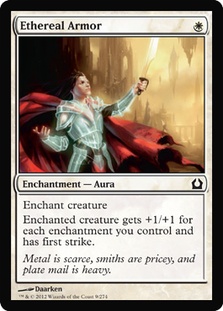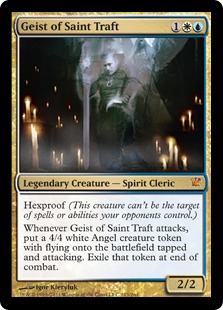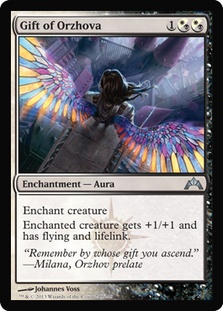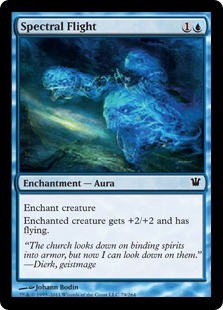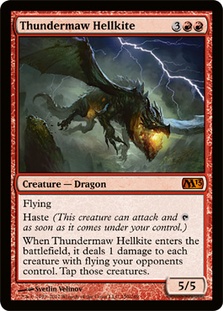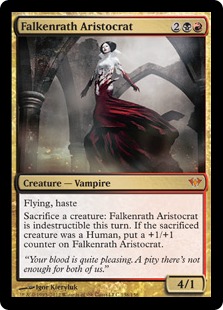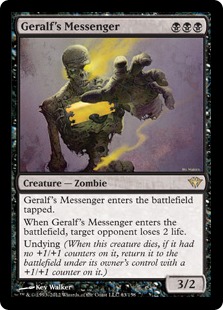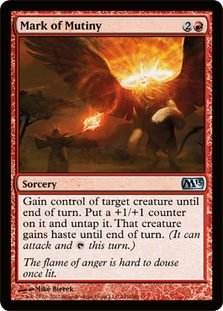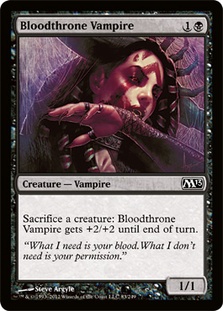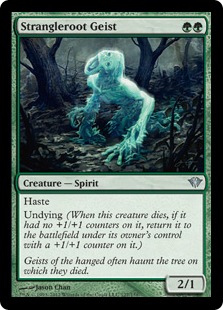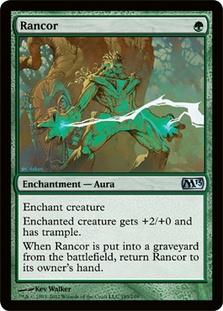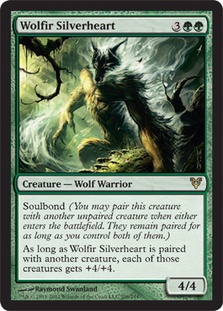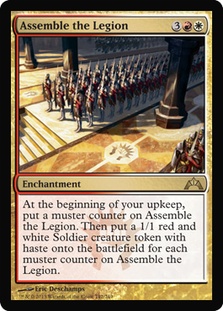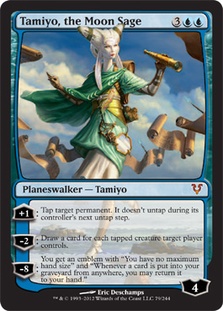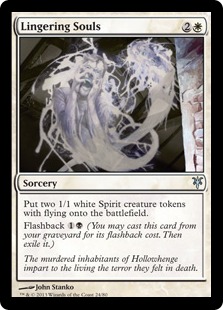What is midrange, and how does it win? Why is it good? There are a multitude of answers, but quite simply a midrange deck is neither aggro nor control and tends to play somewhere in the middle. Their threats are big, and their answers are plentiful. They to try to win the game through the sheer power of their cards or through powerful interactions that gain them a significant advantage. Midrange decks are slower than aggro decks, but they still usually win by attacking with cards like Thragtusk or Restoration Angel and occasionally have big finishers like Thundermaw Hellkite or Angel of Serenity.
Midrange decks were not my favorite strategies in the past because the individual card quality was just not able to support such decks. When cards like Spiritmonger are the finishers of choice, it becomes quite clear that you are not going to be able to beat up on pure control decks. This left a sour taste in my mouth because I was never really able to grasp just what it meant to play a midrange deck and be successful. I always opted for the hyperaggressive decks, the control decks, or the combination of the two in aggro-control (like Delver decks from last year). These three archetypes were pretty much all I played because combo decks felt like a cop-out and midrange decks just felt terrible.
Fast forward to the current Standard era and you see midrange decks flourishing. As new cards and sets have been printed, we’ve gotten bigger and better threats at a lower cost, which allows for midrange decks like Junk Reanimator and Naya to be successful. At a point, it becomes clear that the strategy itself doesn’t really need to be cohesive as long as the cards you’re casting are all individually powerful and give you enough time or generate enough resources to outclass the opponent. Your threats need to hit hard, and they need to be resilient. You also need ways to interact with aggressive decks in the early parts of the game or have things to stabilize the board once you hit the "sweet spot" on your curve.
This usually implies Thragtusk.
The Resurrection of Midrange
Since the Pro Tour in Montreal, Standard has come a long way. Every week, a different strategy rises to the top, only to seemingly fade away into the night as another monstrosity takes its place. The best deck fluctuates from week to week, and the players who stay on top of that curve are the ones doing well at events.
At the moment, midrange decks are all over the place. Thragtusk is back with a bit of a chip on his shoulder, and the friendly Brad Nelson token that tags along isn’t very happy either. And when you finally find both of the spears to take down the Beasts, a timely Unburial Rites just continues the torture. For aggressive decks, this type of strategy is a nightmare, and that is the primary reason that aggressive decks have almost fallen off the map completely!
While Naya Blitz, a hyperaggressive Human-based deck, won a Standard Grand Prix just a few weeks ago, it’s quite apparent that people have "gotten wise" to its tricks. It’s much harder for it to function when everyone is playing removal spells and following those up with Thragtusk or Sphinx’s Revelation. Add to that the fact that Naya Blitz is incredibly inconsistent, as its draws are either unbeatable or unplayable, and you have a recipe for disaster! I think that aggro decks could easily come back in a big way as long as they’re built for the right metagame and can prey on people using Thragtusk to their advantage.
Fight or Flight
While aggressive decks aren’t necessarily bad, I do think they have a tough time gaining traction against such consistent and persistent life gain and board advantage. As I’ve written about before, Thragtusk is the pinnacle of interaction. The decks that have to trudge through multiples in order to win usually lose after the second copy or so, making life difficult for anyone who is trying to attack on the ground. As I’ve also written about before, the way to trump this is to ignore Thragtusk, and this can be done a variety of ways.
Certain archetypes are traditionally strong against Thragtusk decks because they forego playing into the Thragtusk plan by finding a way around it. Mono-Red Aggro used to do this with Pyreheart Wolf, Thundermaw Hellkite, or trying to outpace them by flooding the board with early threats and dealing enough damage to push through the final points before the Thragtusk deck got to untap. The latter isn’t always a possibility thanks to the existence of cards like Centaur Healer and Abrupt Decay, but the first two are still fine options that most red decks don’t even play anymore. If they want to succeed, they have to adapt.
Similarly, the B/R Zombie decks popularized by Jon Bolding at Grand Prix Charleston last year used both Falkenrath Aristocrat and Thundermaw Hellkite to fly over the life-gaining nuisance. Along with hard-to-kill threats like Geralf’s Messenger and Gravecrawler, this strategy led Jon to victory over the likes of Gerry Thompson, Pat Cox, and Reid Duke. While the mana base was shaky due to Cavern of Souls alongside varying creature types, his diverse threats were strong against a variety of control and midrange decks alike and really showcased how a traditionally aggressive deck could "go bigger" than Thragtusk by playing gigantic, haste-powered fliers.
At this stage of Standard with Gatecrash legal, I think it is high time for these strategies to return. With midrange decks ruling the roost, we have to find threats that are resilient to their removal spells and that can get around their more powerful creatures.
The Short List
The following is a list of threats and decks that are great against Thragtusk and midrange decks in general. Sometimes you need a specific combination of cards rather than individual threats, as it isn’t always easy for one card to overcome something as powerful as Thragtusk.
This combination of cards, popularized by the Bant Hexproof deck that won Grand Prix Atlantic City a few months ago, uses powerful hexproof creatures alongside potent Auras to boost them to unspeakable levels of strength and ultimately close the game before the opponent can find a way to interact! While this particular strategy is a glass cannon, only a few cards in the format can actually interact with the hexproof creatures.
Liliana of the Veil is starting to see more play in Jund midrange decks and even Esper Control as a way to pressure other control decks and to give them outs to these kinds of decks. Devour Flesh is another popular answer, making Bant Hexproof a risky proposition if you face the wrong matchup! The good news is that you can play Avacyn’s Pilgrim and Arbor Elf to protect yourself from sacrifice effects.
Bant Hexproof is also pretty weak to Supreme Verdict, as it is uncounterable and generally takes away two to four cards when cast. While Supreme Verdict is annoying, you can incorporate sideboard options like Rootborn Defenses or Nevermore to protect yourself from this kind of sweeper. If you can stomach the occasional blowout from a prepared opponent, then this type of deck is something you should really try out in order to get around Thragtusk.
Creatures (24)
- 4 Arbor Elf
- 4 Invisible Stalker
- 4 Avacyn's Pilgrim
- 4 Geist of Saint Traft
- 4 Silverblade Paladin
- 4 Sublime Archangel
Lands (20)
Spells (16)
Sideboard

Next up:
While these two cards shouldn’t always be in the same deck, I do think that the ability to play one or the other should heavily influence how you build your aggressive deck. You need ways to fly over Thragtusk, and these two creatures do it best. I would personally prefer to play with Falkenrath Aristocrat since it comes down a full turn faster and is a little harder to kill. However, if you’re planning on playing a red deck without black, then Thundermaw Hellkite is still acceptable.
The added benefit of Thundermaw Hellkite giving you a way around Lingering Souls or defensive Restoration Angels is also a plus, but being vulnerable to Ultimate Price and Supreme Verdict isn’t so great. Of course, there are answers to both of these that control decks play—cards that can hinder your plan like Azorius Charm—but these types of creatures are for pressuring Thragtusk decks more than anything. They’re fine finishers against the rest of the field and will often be key in racing situations, but they have their strengths and weaknesses in various matchups.
This guy’s message seems to have been forgotten. I hope he comes back in a big way because he has always been one of the most frightening threats for me to see on the other side of the table as a control player. When backed up with removal, resilient threats like Geralf’s Messenger are hell against a variety of decks but are especially good at fighting Thragtusk. The draining of life helps negate some of the life gained by Thragtusk, and the bonus of undying matches up well to the additional body Thragtusk leaves behind after it dies.
While Geralf’s Messenger isn’t always enough to combat these strategies, black and red decks have a lot of other ways to overcome such a powerful monster. The interaction I’m specifically interested in is Mark of Mutiny (or other Threaten effects) along with sacrifice outlets. I think that Bloodthrone Vampire is probably the best for the job since it combos quite nicely with both Geralf’s Messenger and Gravecrawler to apply the beats. Blood Artist might also be a reasonable addition to this archetype because it allows for some combo-esque kills with Bloodthrone Vampire and Falkenrath Aristocrat, but I can see the appeal of wanting all of your creatures to be able to pressure the opponent on their own.
Creatures (26)
- 4 Bloodthrone Vampire
- 4 Diregraf Ghoul
- 4 Gravecrawler
- 4 Falkenrath Aristocrat
- 2 Hellrider
- 4 Geralf's Messenger
- 4 Knight of Infamy
Lands (24)
Spells (10)

Although Geralf’s Messenger isn’t that frightening against a field full of Pillar of Flame, the current metagame is not prepared to interact with undying. In fact, I would go so far as to say that Strangleroot Geist is also pretty well positioned at the moment, though it needs a little help in order to fight against a midrange deck. Luckily, Rancor is a card that green decks have access to, and I wouldn’t be surprised to see something akin to Brian Kibler G/B Ooze deck take root. There have been a few interesting brews as of late featuring Strangleroot Geist, and this one is one of my favorite 4-0 decks from Magic Online in the last week:
Creatures (32)
- 4 Arbor Elf
- 4 Strangleroot Geist
- 4 Huntmaster of the Fells
- 4 Wolfir Silverheart
- 4 Flinthoof Boar
- 4 Burning-Tree Emissary
- 4 Ghor-Clan Rampager
- 4 Gyre Sage
Planeswalkers (3)
Lands (21)
Spells (4)
Sideboard

G/R decks that are trying to go over the top of Thragtusk have been doing quite well lately on Magic Online. Doing so with cards like Wolfir Silverheart and Ghor-Clan Rampager is an improvement over something like Naya Blitz where you are all in on your first few turns and just have to pray they don’t have an answer. I absolutely love Domri Rade at the moment because he allows you to generate card advantage while also threatening the ability to kill opposing creatures with ease. Along with Wolfir Silverheart, it shouldn’t be hard to take down virtually any opposing threat!
While there are other green-based decks in Standard, the appeal of this one is obvious. Your creatures can grow very large at a rapid pace, and many of your cards have multiple functions. Gyre Sage can act as a Tarmogoyf proxy and double as a way to accelerate out Wolfir Silverheart a turn early. Burning-Tree Emissary can help flood the board early to pressure an aggressive deck while also acting as an incredible defensive measure on turn 3 alongside Domri Rade. Even Huntmaster of the Fells can be one of the most offensive or defensive creatures in your arsenal depending on the situation at hand.
Next up is a card I’ve had a crush on for a few weeks:
Ah, yes. Bitterblossom, how I’ve missed thee. Unfortunately, Assemble the Legion costs more than twice as much mana, but it doesn’t drain my life and creates a lot of creatures much faster than Bitterblossom! We may not have synergy like Spellstutter Sprite or Mistbind Clique to accompany such a powerful card, but we do have a threat that is incredibly difficult to interact with and can easily take over a game in just a few short turns.
Assemble the Legion is in kind of a weird spot at the moment because it just isn’t good against aggressive decks. You will easily get run over if you don’t have anything to help you stabilize before you cast Assemble the Legion, but it is hands-down one of the best cards at your disposal when fighting off Thragtusk decks! After playing with it in a few tournaments against both midrange and control, I can safely say that it is the real deal!
The best decks for Assemble the Legion are ones that can accelerate into it. I’m a fan of both Farseek and Avacyn’s Pilgrim in a deck running Assemble the Legion, as well as Arbor Elf if the mana base can handle it. Obviously, there will be situations where it will become readily apparent how bad Assemble the Legion is against aggressive decks, but there are few ways to trump midrange decks that are actively good against opposing aggro decks.
Planeswalkers may not be great in metagames full of hyperaggressive decks, but they are awesome in formats full of control and midrange decks. At the moment, I feel like Tamiyo, the Moon Sage is the best card that no one is really playing. It locks down Thragtusk, draws cards, and its ultimate can easily win the game alongside Thought Scour, Searing Spear, and a variety of other utility cards! Tamiyo is a great finisher since not many decks have ways to deal with planeswalkers other than attacking, so having a deck full of removal, counterspells, and card draw is exactly where you would want Tamiyo.
Flying creatures are also important at the moment. One of the easiest ways to get around Thragtusk is flying, so access to something like Lingering Souls can be invaluable. I’m not sure if a card like Intangible Virtue is worth it, but Sorin, Lord of Innistrad is pretty amazing with it. Additionally, Sorin generates multiple threats or blockers against Thragtusk decks, and his emblem helps make your Lingering Souls tokens into high-impact threats!
Creatures (4)
Planeswalkers (5)
Lands (28)
Spells (23)
- 3 Syncopate
- 2 Think Twice
- 4 Lingering Souls
- 4 Azorius Charm
- 4 Supreme Verdict
- 3 Detention Sphere
- 3 Sphinx's Revelation
Sideboard

…
While midrange and control decks aren’t the only things you should be worrying about, they should definitely be at the top of your list when it comes to building your deck to win the tournament. At the moment, everyone is trying to "go bigger" than everyone else with cards like Angel of Serenity, Unburial Rites, and Thragtusk. You have to find ways around these cards, and I sincerely hope the above list will help. There have been a lot of interesting fluctuations in Standard over the last few months, and I don’t foresee that stopping any time soon!
The StarCityGames.com Invitational is going to be in Atlanta in just a few weeks, and I will be preparing for both Standard and Legacy wholeheartedly. We will be forming a makeshift team of Roanokians for the event, so expect to see us at the top of the standings! If you’re going to be there, be sure to bug Brad Nelson to get him to sign your player tokens! I can’t wait to get mine later this year, but good things come to those who wait. I know I’m looking forward to it, so please feel free to bug me about signing them once they’re released!
Thanks for reading.
strong sad on Magic Online
@strong_sad on Twitter


